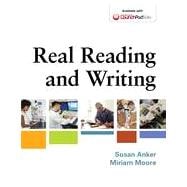Miriam Moore, a developmental and ESL specialist from Lord Fairfax Community College, collaborated with Susan Anker to provide students with an integrated reading and writing package. Students connect reading and writing with their real lives through practical examples, model writing samples, and readings that are both engaging and relevant to their lives. To keep students from getting overwhelmed, the book focuses first on the most important concepts in each area, such as the Four Basics of the Reading and Writing Process; Four Basics of each rhetorical strategy; the Four Most Serious Errors in the grammar section; and the academic skills of summary, analysis, and synthesis.
This edition can be packaged with LaunchPad Solo for Real Reading and Writing, which includes LearningCurve, the adaptive online quizzing program with immediate feedback that 95% of students surveyed recommend to their peers. Additional online multiple-choice grammar exercises offer even more practice on the grammar concepts students find most challenging.








